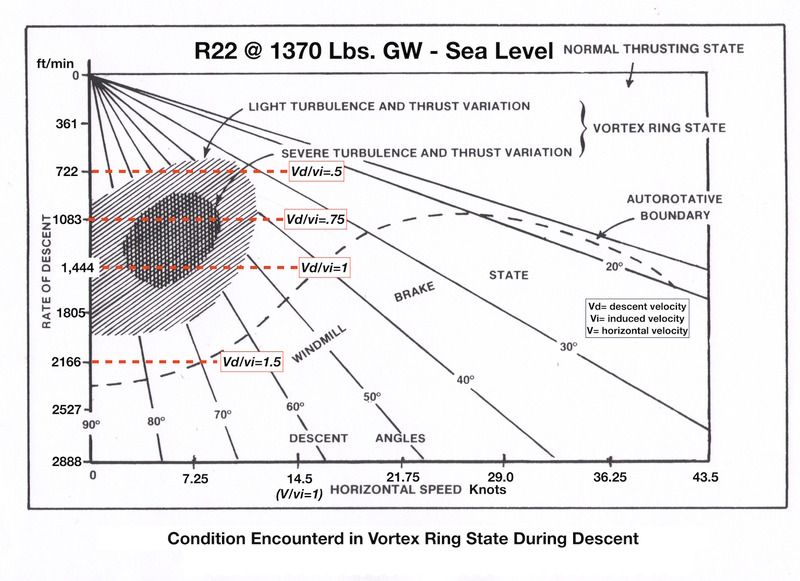Since we are so nicely going around in circles and FICH is rather frustrated with us not getting it.
The one for the R22

Just for arguments sake, can we agree on the area with light turbulence and thrust variation as IVRS, and the dark area is FDVRS?
In that case: I believe that no many of us have ever experienced FDVRS. All we talk about is IVRS. Charts for other helicopters are similar.
If you go straight down, you are in IVRS, not FDVRS, when you descend with 40 degrees, neither. And after a while you drop out of VRS at the bottom.
Now what are we talking about? Is it really that important, to get out of VRS or IVRS as fast as possible. The goal one has as an instructor is to teach students to use superior skill in judgement, so that they don't have to use superior piloting skill.
Let's assume the Vulcan Technique works as advertised. Great! Cool! How much better? Somebody should find out with calibrated instruments and a series of VRS test flights. Would be an interesting paper for a aeronautical engineering student.
As soon as the pilot feels the low frequency airframe vibration and the trust variation, he/she should take action. The these indications must not necessarily come from VRS. It might be just the loss of ETL and some SWP. In which case VT would not save the day.
A down draft in the lee of a mountain isn't VRS, but it might feel quite similar.
To show different techniques to students is a great thing and letting develop a high sink rate and getting out of it, is something every student should know, but I believe that this is more a demonstration of the awkward aerodynamics of the helicopter than something useful in everyday life.
"All those terrible accidents" that FICH stated, do not happen. They are rather few and far between. VRS accidents are not on "most wanted" list of aviation authorities in the world. That's probably just because the training works pretty well to avoid the shaded area in the first place. When you have to use the Vulcan Technique to get you out of a desperate situation, you have already pretty much ****** it up before.
One thing might speak in favour of the Vulcan Technique. The two accident reports I found which suspect VRS stated that the pilot tried to arrest the sink rate by adding power; the natural reaction but makes it worse. A bit of uncoordinated flight or only stick forward might have saved the day here. Apparently the pilots didn't realise that they were in VRS.
The conclusion would be: show the students the Vulcan, but hammer it into their brain, to avoid VRS and if they get low frequency vibration and thrust variations, don't try to salvage an approach by just adding power and flying uncoordinated. Start again. Go around. Speed up. It might have been something else than VRS. It is easy to identify something when you want it to happen. It is much harder, if it surprises you.
It is an additional tool for the (advanced) pilot, but it is not the ultimate thing one would use in panic mode and it isn't universal. In a French of Russian helicopter you must reverse the movements. That just does not work for a standard emergency technique. Keep it stupid and simple.